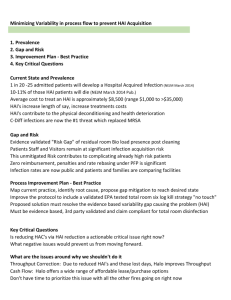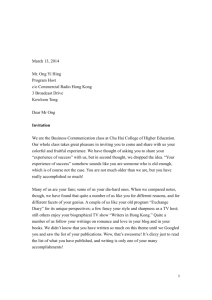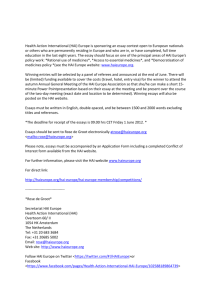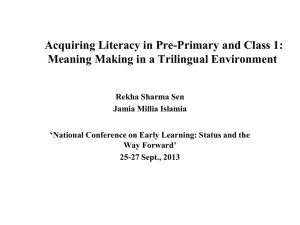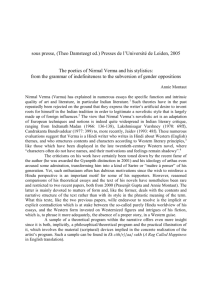HelpAge Training & Development Policy
advertisement
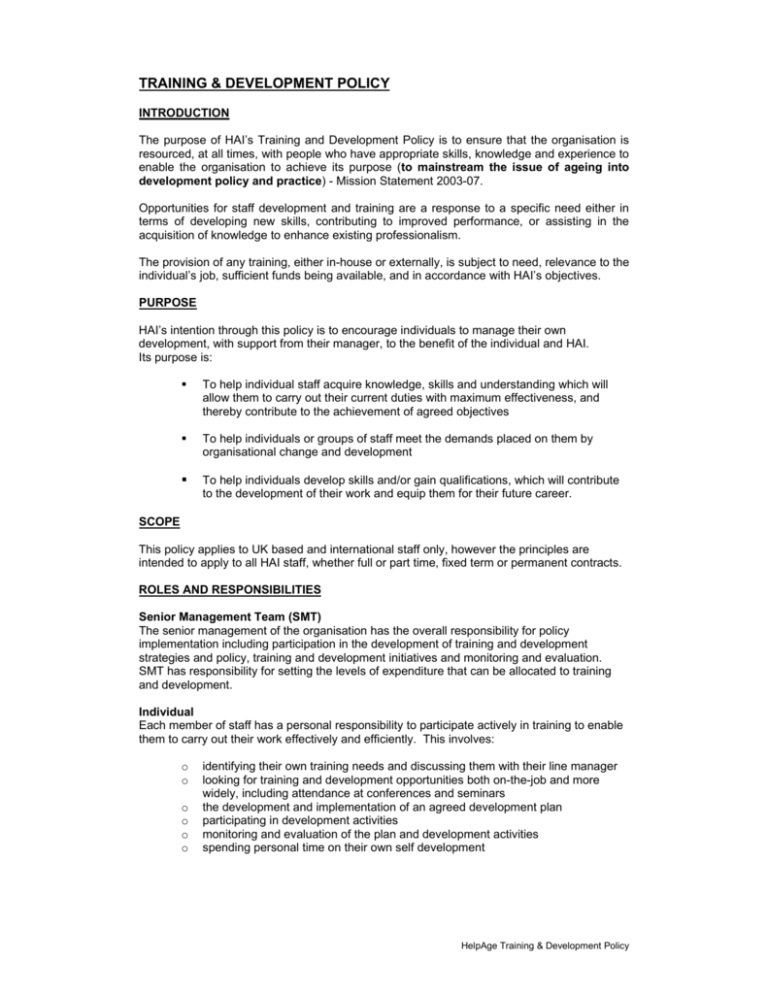
TRAINING & DEVELOPMENT POLICY INTRODUCTION The purpose of HAI’s Training and Development Policy is to ensure that the organisation is resourced, at all times, with people who have appropriate skills, knowledge and experience to enable the organisation to achieve its purpose (to mainstream the issue of ageing into development policy and practice) - Mission Statement 2003-07. Opportunities for staff development and training are a response to a specific need either in terms of developing new skills, contributing to improved performance, or assisting in the acquisition of knowledge to enhance existing professionalism. The provision of any training, either in-house or externally, is subject to need, relevance to the individual’s job, sufficient funds being available, and in accordance with HAI’s objectives. PURPOSE HAI’s intention through this policy is to encourage individuals to manage their own development, with support from their manager, to the benefit of the individual and HAI. Its purpose is: To help individual staff acquire knowledge, skills and understanding which will allow them to carry out their current duties with maximum effectiveness, and thereby contribute to the achievement of agreed objectives To help individuals or groups of staff meet the demands placed on them by organisational change and development To help individuals develop skills and/or gain qualifications, which will contribute to the development of their work and equip them for their future career. SCOPE This policy applies to UK based and international staff only, however the principles are intended to apply to all HAI staff, whether full or part time, fixed term or permanent contracts. ROLES AND RESPONSIBILITIES Senior Management Team (SMT) The senior management of the organisation has the overall responsibility for policy implementation including participation in the development of training and development strategies and policy, training and development initiatives and monitoring and evaluation. SMT has responsibility for setting the levels of expenditure that can be allocated to training and development. Individual Each member of staff has a personal responsibility to participate actively in training to enable them to carry out their work effectively and efficiently. This involves: o o o o o o identifying their own training needs and discussing them with their line manager looking for training and development opportunities both on-the-job and more widely, including attendance at conferences and seminars the development and implementation of an agreed development plan participating in development activities monitoring and evaluation of the plan and development activities spending personal time on their own self development HelpAge Training & Development Policy Line Managers Line managers have a key role in the training and development of their staff. They should ensure that their staff are trained to carry out their present job effectively and receive training to develop them for future opportunities. This involves: o o o o o o o identifying training, development and support needs with staff ensuring plans are developed to help meet these needs providing on the job training where possible providing opportunities for personal development, for example by exploring new areas of work reviewing, monitoring and evaluating development activities and their effectiveness. Identifying opportunities to practise new skills and demonstrate knowledge (this could include briefing other staff on specific subject areas) monitoring and ensuring effective and fair use of the budget Personnel Personnel are responsible for: o o monitoring the training and development policy and reporting back to SMT any issues arising providing support and advice to managers and staff on the implementation of the policy, identification and meeting of needs and where possible information about courses and training resources. IDENTIFYING TRAINING & DEVELOPMENT NEEDS Recruitment/Induction/Skills gaps Assessment of the skills and knowledge an employee needs to do their current job successfully can be made against the job description and person specification. This is normally done automatically throughout the recruitment process (e.g. using application forms, test results) and can be explored further during the induction period. Performance Management Training and development needs are usually identified during the performance appraisal process and a performance development plan agreed. This is to ensure that the employee can fulfil the requirements of the job as well as ensure they have the skills to complete the objectives that have been agreed. (See Performance Management Policy and Manager’s Guidelines). Organisational changes Organisational changes, for example installation of new software or the introduction of a new policy, can come at any time and whenever they do, an analysis of training needs should be carried out and appropriate training given. Organisational objectives Some training and development needs would be determined by HAI’s strategic goals. For example, if HAI decided, within their IT objectives, that to improve efficiency all staff had to use their electronic diaries, appropriate training would need to be organised. MANDATORY TRAINING Some training is mandatory for certain staff and these courses are outlined below. Training/Development Induction Health & Safety Security Recruitment & Selection Performance Management Finance Who? All All Staff going to Medium or High Risk Countries Managers All Programme Managers HelpAge Training & Development Policy APPROACHES AND METHODS OF TRAINING AND DEVELOPMENT For many staff the greater part of their training will be on the job, however, from time to time it may be necessary for employees to attend external training events. Having identified a learning/development/support need, the next step is identifying the most effective way to meet the need. It is critical that the development need is specific and required learning objectives clearly defined. There are many ways to develop knowledge, skills, attitude including: Internal opportunities/activities: - Attending meetings, seminars, conferences, lunch time briefings Secondments Temporary additional responsibilities Mentoring Coaching/on the job training Job rotation/development Self directed learning – e.g. computer based, internet Project work External Training - Training courses Professional qualifications Information about training courses, seminars and conferences is available from the Resources Centre. Personnel can assist in selecting appropriate courses and may be able to provide reviews of external training Sharing learning/experiences In the interests of cost effectiveness and sharing learning, if at all possible there should be a commitment and arrangements made to share the learning particularly from the external training. This could be; - a briefing session/presentation oral or written on the key aspects of training sharing of ideas the training may have raised running a mini – in house training session sharing handouts and guidance notes. Self Development - reading distance learning training and development programmes professional membership evenings membership of external committees TRAINING BUDGET The HAI training budget is currently calculated on the basis of an average of £300 per person per year. Each department Director is responsible for the total budget for their department and ensuring that the budget is used fairly and appropriately. Some of the budget may be contributed to organisation wide training. Requests for funding must be agreed in the first instance with the line manager. HelpAge Training & Development Policy The level of financial support HAI will provide for any training or development event is discretionary and will be prioritised taking into consideration the following; Relevance of the event to the individuals current job description Perceived added value to the team/department Priority against organisational need and planned activities Cost, method and appropriateness of the event Previous funded opportunities Time necessary TRAINING RECORDS A training record for each member of staff will be kept centrally by the Personnel department. Therefore, line managers must ensure that Personnel are kept up to date on any training or development that has taken place. Professionals who are subject to CPD requirements, must maintain their own CPD record for the purposes of their respective professional body. ASSISTANCE FOR FURTHER OR HIGHER EDUCATION HAI senior management team will consider requests for assistance towards further education course fees and approved professional qualification course fees, providing that there is a written development plan that fits in with the corporate aims of the organisation. The following guidelines are set out for use by management: Authorisation Any staff member who wishes to pursue a course of Further or Higher Education should complete an application form (Appendix A) and give it to their line manager and Department Director, this should be copied to the HR Manager. The request should include; details of a development plan that is linked to the departments plan details of the course of study cost duration day release/distance learning reasons for wishing to pursue the course of study how it will benefit the individual and department how it is likely to impact the rest of the department/team The Department Director in conjunction with SMT will be responsible for making a decision within the context of the department plan, the organisational objectives and the available budget. Where a course of study is approved, the individual will be reimbursed for up to 50% (pro-rata for part-time staff) of the cost of tuition fees and examination fees. Payment of fees for resits are at the discretion of SMT. Day release Day release will be considered by SMT and this must be approved through the Department Director. Consideration will be made to departmental workload and resources. Study Leave Study Leave will be granted by SMT for those needing to take examinations. Study leave dates need to be agreed in advance by the line manager who will need to plan for a reallocation of work during any absence. HelpAge Training & Development Policy Resits will not normally be supported by SMT other than in exceptional circumstances that must be authorised in advance by the Department Director and the HR Manager. Employees needing to do resits will normally be expected to do so in their own time. Any other study leave is granted at the discretion of the line manager. The decision will be made based on the same criteria that was used in authorising the study programme originally (see Authorisation). If you undertake a long-term further education/training course you will be expected to attend all classes, unless you are ill. An unsatisfactory attendance record may result in financial support and time off to attend the course being withdrawn. Should you wish to discontinue the course or fail the examinations twice you should discuss this with your line manager and agree an appropriate course of action. Repayment If an individual obtains a professional qualification or any further education qualification and subsequently leaves HAI of their own accord within a specific period after completion, the following repayment of HAI’s financial assistance will be applied: Within 6 months 6-12 months 12-18 months 18 months – 2 years 100% repayable 90% repayable 75% repayable 50% repayable The same rule will apply if an individual leaves HAI before completing the course of study where HAI has sponsored and paid for the course. However, if the individual is made redundant, this rule will not apply. An external study course application form (Appendix A) will need to be obtained from the Personnel Department and a signed copy returned to them before a course of study starts. MONITORING AND EVALUATION All internal courses will be evaluated at the end of each course when participants are asked to complete an immediate reaction questionnaire. Following attendance at an external event, staff are required to complete a training evaluation form (Appendix B) and return it to Personnel. This enables the HR Manager to monitor the quality of external events and ensure HAI gets value for money. Other means of evaluating training and development include; Examinations and practical tests, possibly both before and after training Discussions about the effectiveness of the training/development, particularly after one-to-one coaching or mentoring Line managers assessment of enhancement of skills/knowledge and overall performance as well as changes in behaviour The HR Manager will carry out six monthly reviews of training expenditure and recommend organisational training and/or development in accordance with performance development plans. HelpAge Training & Development Policy
